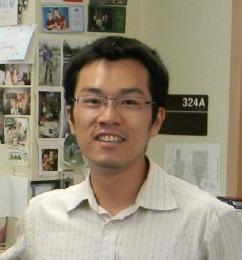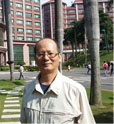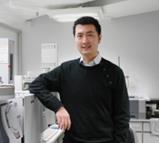
2016 International Conference on Water Resource and Environment (WRE2016)
July 23rd - 26th, 2016, Shanghai, China

 |
Prof. Dr Miklas Scholz CWEM, CEnv, CSci, CEng, FHEA, FIEMA, FCIWEM, FICE, Fellow of IWA Chair in Civil Engineering, Head of the Civil Engineering Research Group, Civil Engineering Research Group, School of Computing, Science and Engineering, The University of Salford |
| Speech Title: Advances in Wetlands for Water Pollution Control Abstract: Constructed wetlands are increasingly seen as an established technology for water pollution control. Recent technological advances in treatment units and scientific progress in areas such as molecular microbiology will be highlighted. Furthermore, the subject area has been broadened to account for more multi-disciplinary approaches such as the ecosystem services concept to solve engineering science challenges with a holistic angle. Broad water and environmental engineering aspects relevant for the drainage and treatment of storm water and wastewater are outlined, providing a descriptive overview of complex ‘black box’ treatment systems and general design issues involved. The fundamental science and engineering principles in wetland engineering are explained. Standard and novel design recommendations for predominantly constructed wetlands and related sustainable drainage systems are provided. The presentation deals comprehensively not only with the design, operation, maintenance and water quality monitoring of traditional and novel wetland systems, but also with the analysis of asset performance and modeling of treatment processes and performances of existing infrastructure predominantly in developed but also developing countries, and the sustainability and economic issues involved. Solutions to pressing water quality problems associated with constructed treatment wetlands, integrated constructed wetlands, farm constructed wetlands and storm water ponds, and other sustainable biological filtration and treatment technologies linked to public health engineering are explained. Case study topics are diverse: wetlands including natural wetlands and constructed treatment wetlands; sustainable water management including sustainable drainage systems; specific applications such as wetlands treating hydrocarbon and piggery wastewater. The research projects are multi-disciplinary, holistic, experimental and modeling-orientated. | |
 |
Prof. Sam Kacew Associate Director of Toxicology, McLaughlin Centre for Population Health Risk Assessment at the University of Ottawa Professor, University of Ottawa and Scientist, Institute for Population Health, University of Ottawa |
| Speech Title: UNDERSTANDING ROLE OF FLAME RETARDANT CHEMICALS IN SOCIETY: BENEFITS, ENVIRONMENTAL EXPOSURE AND HUMAN HEALTH Abstract: Flame retardants (FR) are used to mitigate fire risk by increasing ignition resistance of polymeric materials and delaying fire growth. FR are employed to prevent fires and predominantly are found in printed circuit boards, electronics electrical equipment, construction materials, furniture, appliances, transportation (e.g. seats on buses, trains or airplanes), and automotive parts. The importance of FR in our society is well-established through the ubiquitous presence of these chemicals in consumer products that result in the significant number of lives saved. In particular, this presentation will focus on 2,2’,6,6’-tetrabromo-4,4’-isopropylidenediphenol (tetrabromobisphenol A: TBBPA) a high production volume and efficient compound used in the manufacture of printed circuit boards. In addition to the efficacy of FR, considerable information regarding their potential hazard is available. Hence the toxicology related to FR has undergone comprehensive testing. In bacterial mutagenicity tests, two mutagenicity tests in Saccharomyces cerevisiae D3, a mammalian chromosome aberration assay using human peripheral lymphocytes and an unconventional in vitro Sp5/V79 and SPD8 recombination assay TBBPA produced negative responses. In a multi-generational study with TBBPA there were no marked effects on fertility, reproductive capacity, development, growth, behavior, neurotoxicity and pathology in rats. Similarly in a 90-day oral toxicity study in rats with TBBPA at doses of 0, 100, 300 or 1000 mg/kg/day there were no significant changes in mortality rate, body and organ weights, clinical chemistries, histopathology and a functional observational battery tests for neurotoxicity. The only change at 1000mg/kg was an increase in serum thyroxine (T4), the inactive form, but this change was accompanied by no marked alterations in T3, the active form, thyroid stimulating hormone (TSH) as well as histopathology. Similarly treatment with TBBPA for 2 generations in rats with doses of 0, 10, 100 or 1000mg/kg/day produced no significant changes in all parameters examined except for an elevation in serum T4; butthis was not associated marked alterations in T3, the active form, thyroid stimulating hormone (TSH) as well as histopathology. Although a study found evidence of increased incidence of uterine tumors in rats exposed to 1000 mg/kg/day for 2 years, it needs to be emphasized that a dose of 1000 mg/kg/day is not biologically relevant and would not be encountered by humans or wildlife in the environment. Taken together, our findings demonstrate that exposure to TBBPA does not present a risk to the environment and human health whilst its use as FR to stop fires protects lives, property and the environment. | |
 |
Dr. Shou-Qing Ni Associate Professor, School of Environmental Science and Engineering, Shandong University |
| Speech Title: Anaerobic Ammonia Oxidation: Fast Start-up Strategy and Process regulation Abstract: From discovery in the early 1990s to completion of full-scale anammox reactor, it took almost two decades to uncover the secret veil of anammox bacteria. There were three milestones during the commercialization of anammox: the development of the first enrichment culture medium, the completion of the first commercial anammox reactor, and the fast start-up of full-scale anammox plant. Till now, the culture of anammox bacteria experienced a big progress through two general strategies: (a) to start up a reactor from scratch and (b) to seed the reactor with enriched anammox sludge. The first full-scale anammox reactor took 3.5 years to realize full operation using the first approach due to several reasons besides the lack of anammox sludge. On the other hand, the first Asian anammox reactor started up in two months, thanks to the availability of anammox seed. Along with the implementation of anammox plants, anammox eventually becomes the priority choice for ammonium wastewater treatment. For the first strategy, the reactor configuration is very important. Granulation also improves anammox application. The introduction of the exotic anammox sludge to seed a granular reactor is a good choice. Of course, anammox faces problems, such as the low total nitrogen removal and operational stability. We proposed process regulation via the help of chemical reaction and biological process. | |
 |
Prof. Walter W. Loo Environment & Technology Services Chief Technology Scientist of Sino-Afraica Development Fund United Nations Peace Ambassador |
| Speech Title: Innovative Irrigation Water without Pesticides for Organic Growers Abstract: The PRC calls for new innovations in farming practice while increasing the GDP per acre. The new irrigation water will increase the GDP per acre increase by 3 folds. The open door policy for the last 30 years brought in toxic pesticides and chemical fertilizers from the west and caused serious damages to human health and farmlands. The new irrigation water consists of nano-bubble gases like activated oxygen, nitrogen and carbon dioxide. These are all natural fertilizers. The nano-bubbles penetrate into seed and plant tissues easily and cause at least 100% increase in crops, vegetables and fruits yields per acre. The activated oxygen in the irrigation water also remediate residual toxic pesticides. It also kills insect larvae in soil which make the farm products into organic grade which increase the value by 300%. | |
 |
Prof. Isen Wang Principal Hydrogeologist, Environment & Technology Services |
| Speech Title: The Applications of Zero Water Discharge (ZWD) Systems
For Environmental and Ecological Management Abstract: China declared the "Zero Discharge Rules which Leave No Toxics Into Our Living Environment And Deliver Blue Sky, Green Land And Clear Water For Many Generations To Come". The achievement of ZWD will provide conservation of water, soil and energy and provide drastic increase in Gross Domestic Products (GDP). Our society’s engine need a major tune up --- it is sputtering. ZWD is achieved in world’s space stations – no toxic air emission and the water is total recycled and solid wastes all come back to earth. This is all done with solar power. These are all achieved under extreme temperature, pressure and zero gravity in space. ZWD can be achieved on earth under much less fluctuations in temperature, pressure and normal gravity environment. ZWD systems are not expensive and will have multiple beneficial returns on investment both financially and environmentally acceptable. The paper will include successful case histories since the mid-1970s. | |
 |
Dr. Hua Zhong Department of Soil, Water and Environmental Science, University of Arizona, U.S. |
| Speech Title: Advanced persulfate-based in-situ chemical oxidation technologies for groundwater remediation Abstract: Contamination of groundwater by chlorinated-solvent chemicals and other refractory compounds (e.g., 1,4-dioxane, MTBE, perfluorocarbons, PAHs) is ubiquitous, and remains a significant human-health and water-resource sustainability issue for many industrialized regions. Extensive commingled groundwater contaminant plumes typically form at the sites contaminated by these compounds. In-situ chemical oxidation (ISCO) is a technology used for cost-effective, long-term management of sources and plumes at these sites. As an ISCO oxidant, persulfate has some advantages over other conventional oxidants (e.g., permanganate and hydrogen peroxide), such as non-selectivity to contaminants, high efficiency, low cost, and safety. However, persulfate needs to be activated to have good performance. We are developing two approaches based on the application of persulfate-based ISCO for direct treatment of the contaminated groundwater. Method 1 employs a permeable reactive barrier supplemented with persulfate oxidant. The barrier would be placed downgradient of a control plane (source zone or plume edge) at sites with shallower groundwater, and persulfate is activated in the barrier for contaminant degradation. Method 2 is for deeper groundwater, and comprises creation of a treatment zone wherein the natural attenuation capacity of the sediment is enhanced through injection of oxidant solutions and activators. Bench-scale batch and column transport experiments were conducted to evaluate technology potential. A variety of Fe-based media, including iron filings, Fe3O4 solids, and several Fe-containing geomedia, were tested for in situ activation of persulfate. Emplacement of Fe3O4and zero-valent iron nanoparticles in porous media for activation of persulfate for deep groundwater treatment was also studied. | |
 |
Prof. Chih-Huang Weng Dept. of Civil and Ecological Engineering, I-Shou University, Taiwan |
| Speech Title: Decolorization of real textile wastewater using persulfate oxidation process catalyzed with zero-valent iron aggregates Abstract: This study evaluated the effectiveness of persulfate (PS) oxidation activated with Fe0 aggregates for removal of true color (ADMI) from a raw textile wastewater. The results of batch experiments showed that decolorization was not effective in either ultrasound-activated or heat-activated PS oxidation; however, a significant decolorization improvement was achieved by applying Fe0 aggregates (PS/Fe0) as catalyst. PS decolorization efficiency system when it was activated by Fe0 aggregates is higher than that of FeSO4 and magnetic nano-size iron. Ultrasound (US) and heat can be used as enhancement tools in the decolorization system. As for the treatment efficiency of a wastewater containing ADMI 850 and 200 mg/L COD, 88% decolorization efficiency and 60% COD removal efficiency were achieved within 30 min in the PS/Fe0/US system at an initial pH of 3.0, PS of 1×10-3 M, Fe0 of 1 g/L, and 30°C, and US of 106 W/cm2. The observed pseudo-1st-order rate of kinetic oxidation was enhanced at higher temperature and PS dosages. An Arrhenius activation energy of 6.69 kcal/mol was calculated, suggesting that higher temperature is beneficial from the ADMI decolorization. The PS/Fe0 process provides a practically feasible technology for treating of real textile wastewater. | |
 |
Prof. Dr. Z. Fuat TOPRAK (BECAUSE OF MILITARY COUP ATTEMPT IN TURKEY, PROF. DR. Z. FUAT TOPRAK (WHO HAS 5 PRESENTATIONS AND ONE OF SESSION CHAIR) COULD NOT ATTEND THE CONFERENCE. BEST WISHES FOR THE ORGANIZING COMMITTEE MEMBERS AND ALL PARTICIPATES) Dicle University Engineering Faculty Civil Engineering Department, 21280, Diyarbakir, Turkey |
| Speech Title: WHAT IS GLOBAL CLIMATE CHANGE: WITH THE PERSPECTIVE OF THE PEOPLE WHO LIVE IT Abstract: Due to its serious impacts upon the environment and on almost all the aspects of the life, the climate change is internationally discussed among all the vital sectors of the life. In this study, the global climate change is explained with the perspective of the people who has no prejudices but live it. Therefore, it is possible to extract the answers of 5 questions frequently asked on the global climate change that the people concerns in their answers. For the goal, herein first, the previous researches performed on the “global climate change” have been abstracted and discussed briefly. Finally, in the light of the current literature, the study is concluded in 15 questions. | |
 |
Dr. Kelvin Sze-Yin Leung Associate Professor, Department of Chemistry, Hong Kong Baptist University, China |
| Speech Title: Photocatalytic transformation of acesulfame: transformation products identification and embryotoxicity study Abstract: The present study aimed to study acesulfamephotodegradation behavior and identity of its transformation products, critical to understanding acesulfame's environmental impact. By a laboratory simulation study in examining acesulfame transformation products and pathways under UV-C photolysis in the presence of TiO2, photodegradation products of acesulfame were isolated and analyzed using the LC-IM-QTOF-MS coupled with LC Ion Trap MS in the MSn mode, followed by an embryotoxicity test. Six new transformation products were firstly identified. The molecular structures and transformation pathways were proposed. Further embryotoxicity tests showed that acesulfame transformation products at the low gL-1 level produced significant adverse effects in tail detachment, heart rate, hatching rate and survival rate during fish embryo development. The identification of additional transformation products with proposed transformation pathways of acesulfame, the increased toxicity of acesulfame after photolysis, and the fact that the accumulation of acesulfame transformation products is increasingly likely make acesulfame contamination even more important. Water resource control agencies need to consider legislation regarding acesulfame and other artificial sweeteners, while further studies are carried out, in order to protect the safety of this most vital resource. | |
 |
Prof. Hi-Ryong,Byun President, Korean Geoscience Union, Korea President, Korean Meteorological Society, Korea Professor,Pukyong National University, Korea |
| Speech Title: New Era on Water Sciences using the hourly/daily Available Water Abstract: Earlier warning of the water related hazards and more reasonable assessment on water environment.For more than 365 days of hourly/daily rainfall data were accumulated with the time dependent reduction function to reflect the runoff and evapotranspiration effects. Then every hour on every date of a region has its own available water value to be comparable with others.Results: 1) On the early warning of flood like hazards. As soon as the hourly precipitation detected, all dangers are calculated. 2) On Drought studies also, as examples, at the end of September drought intensity till next June is predicted. With the 6, 38, and 124 year periodicities of Korean drought, 2015 Sever Drought is predicted at 2008 and proved as true. Droughts till 2100 over Korea were predicted along RCP8.5. 3) With better understanding on season classification and climate division etc., the available water is very useful. The available water every hour and/or date is more valuable, reasonable, and applicable then traditional rain data. It has opened a new era on water sciences. | |
 |
Prof. Ben-Asher Jiftah Professor, Soil Physics,The Katif research Center for Coastal Deserts Development, Sdot Negev regional Council, Israel |
| Speech Title: Thermal Variations of Water in the Nam Song stream / Mekong River: I. A mathematical model Abstract: River water temperature affects nearly every physical property related to water quality management. Therefore, anthropogenic change of water temperature is often undesirable. The objectives of this study were to develop an analytical model describing the thermal regime of a river-dam system. The model will be tested in a second manuscript using data from the Nam Ngum basin in East Asia. The model incorporates three stages a) short time water heating process b) longer time water heating and c)water cooling. Unified and Continuous presentation of the above three solutions describes the complete thermal cycle. It showed that the longer the travel time from a dam (The Nam Song dam in this study) to the measuring point (slow flow rate) the larger the amount of energy absorbed and the higher its associated water temperature. According to the model the temperature of a water volume increases at a rate of ~1.2°C per km downstream when water flow rate is 1 km/hr.When water flow at a rate of 4 km/hr. temperature increases at a rate of ~0.25°C per km downstream. The model turns out to be a simple case of the kinematic wave theory, which is much easier to solve than large scale computer simulation. For successful test of the model the specific parameters of the Nam Song river were used .Naturally, these parameters are changed from one river to another. Thus, to use the model for prediction of thermal regime in other rivers their local specific parameters should be taken. | |